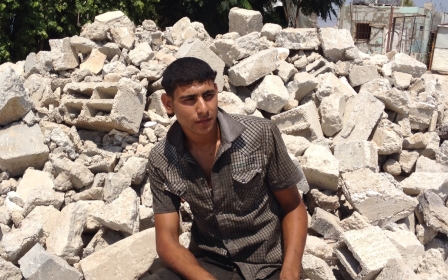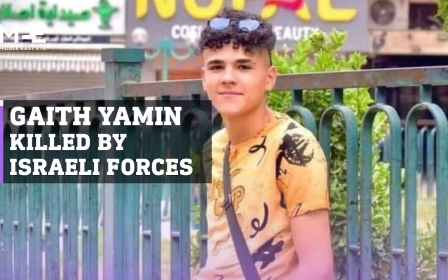Israel is once again using Palestinians as human shields

On 13 May, a 16-year-old Palestinian girl named Ahed Mohammad Rida Mereb was left traumatised after being used by Israeli soldiers as a human shield, according to a report from Defence for Children International Palestine (DCIP).
'One of them [Israeli soldiers] ordered, "Stay where you are, don’t move. You’re a terrorist. Stand in your place until you say goodbye to your brother"'
- Ahed Mohammad Rida Mereb, Palestinian girl, 16
Mereb said that during the incident - which took place during an Israeli raid in the al-Hadaf neighbourhood of Jenin - "One of them [Israeli soldiers] ordered me in Arabic through a small window in the military vehicle, 'Stay where you are and don’t move. You’re a terrorist. Stand in your place until you say goodbye to your brother'."
She added: "I was trembling and crying and shouting to the soldiers to remove me because the bullets were passing over my head."
A week later, Israeli forces were again accused of the same tactics, after a photograph appeared to show them using a Palestinian man as a human shield.
As shocking as these reports are, they come as little surprise to most Palestinians, who know, along with those paying attention long enough, that taking Palestinian human shields used to be common practice in the Israeli military.
New MEE newsletter: Jerusalem Dispatch
Sign up to get the latest insights and analysis on Israel-Palestine, alongside Turkey Unpacked and other MEE newsletters
According to B’Tselem, Israel’s top human rights organisation, the Israeli military has used the human shields tactic since it occupied the West Bank, East Jerusalem and the Gaza Strip in 1967.
'Neighbour procedure'
Despite frequent Israeli claims of Palestinian fighters using their own civilians as human shields - especially during the conflicts between Gaza and Israel - there is no proof of this being the case.
Instead, it has been Israeli soldiers that have employed such strategies on the battlefield under what is known as Israel’s infamous “neighbour procedure”, a friendly way of saying the Israeli military’s human shield procedure.
Up until 2005, the use of Palestinians as human shields by Israeli soldiers had been a standard military practice for the Israeli army, legal under Israeli law.
The Israeli high court only banned the practice following a three-year legal battle brought by seven Israeli and Palestinian human rights groups, who argued that it violated the Geneva Conventions.
Just months after the legal challenge was launched in May 2002, 19-year-old Palestinian Nidal Abu Mukhsan was killed while being used as a human shield. The death of Mukhsan, which was concluded by rights groups to have been Israel’s fault, gave the case against Israel’s human shield policy the push it needed.
When Israel did eventually outlaw the practice, the Israeli army protested. In fact, the then Israel defence minister, Shaul Mofaz, appeared in court to present arguments to repeal the ban.
Israel's defence ministry specifically argued the case for practising this policy inside the occupied West Bank, despite it having been ruled a violation of international law.
Since the use of human shields has been outlawed, the Israeli military has attempted to place the ruling under review several times, arguing that it provides essential protection to their soldiers.
While the Israeli military routinely accuses Hamas of using human shields in Gaza, it simultaneously uses the tactic itself and even argues for it to be legalised again. Former Israeli soldiers speaking to the Israeli group Breaking the Silence have testified to having used human shields after the practice was outlawed.
Copious evidence
Despite copious evidence that Israeli forces have continued to use Palestinians as human shields since the practice was banned, very few Israeli soldiers have ever been brought to justice for their actions.
The last time Israeli soldiers were punished for using a Palestinian as a human shield was in 2010, for an act committed during the Israeli incursion into Gaza in 2008-2009.
No reputable international bodies or organisations have reported a pattern of Palestinians using their own people as human shields
B’Tselem summed up the charges as follows: “The two soldiers in question had ordered a nine-year-old boy, at gunpoint, to open a bag they suspected was booby-trapped. Despite the gravity of their conduct - putting a young child at risk - the two were given a three-month conditional sentence and demoted from staff sergeant to private, some two years after the incident took place. None of their commanding officers were tried.”
The number of cases of Israel's use of human shields recorded by human rights groups, both international and domestic, is ever-growing.
To see this emerge again, especially in the wake of the killing of Palestinian-American journalist Shireen Abu Akleh, should be a turning point, educating the wider world about who is truly using human shields.
No reputable international bodies or organisations have reported a pattern of Palestinians using their own people as human shields.
But the Israeli military quite literally enshrined the tactic into their manuals for decades - and Israeli soldiers now continue to engage in these acts even after they were legally outlawed.
The views expressed in this article belong to the author and do not necessarily reflect the editorial policy of Middle East Eye.
This article is available in French on Middle East Eye French edition.
Middle East Eye delivers independent and unrivalled coverage and analysis of the Middle East, North Africa and beyond. To learn more about republishing this content and the associated fees, please fill out this form. More about MEE can be found here.






